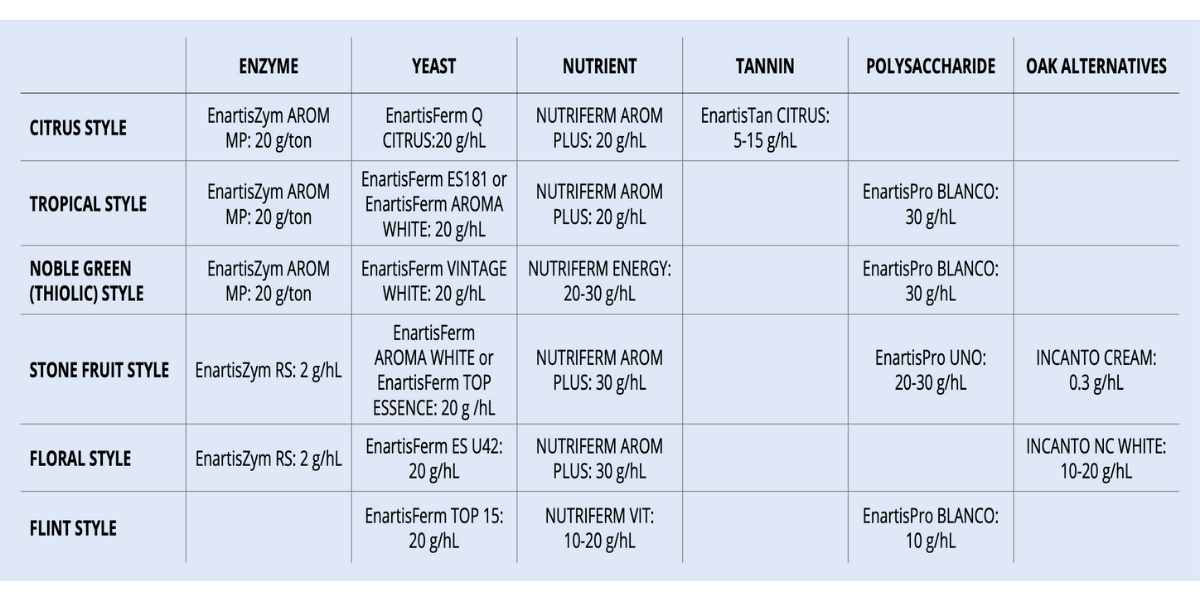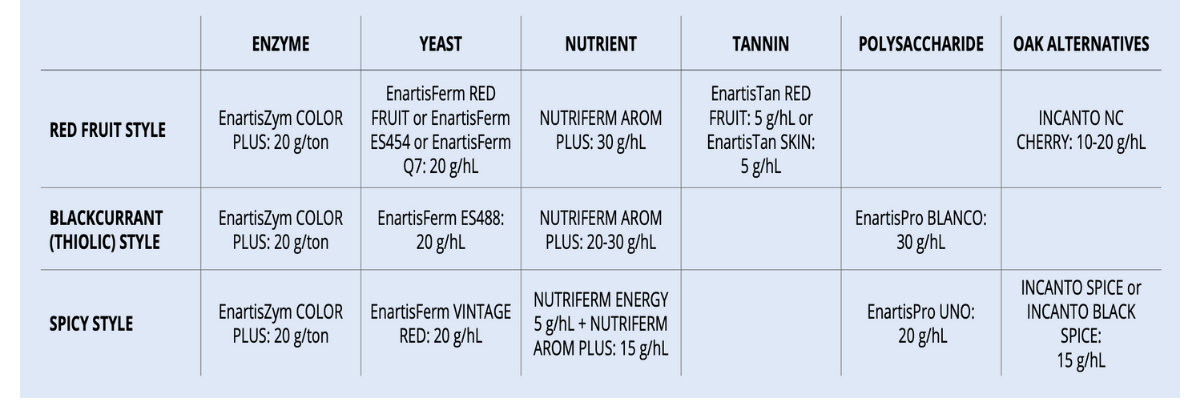Enartis News – What’s your (wine) style?
What is the aromatic style that are you looking for? Here are some suggestions on products and fermentation strategies that can be used to achieve the desired style of wine.
WHITE WINES
Citrus style
Origin: This aroma is considered a varietal aroma related to the presence of terpenes (citronellol, nerol, linalool) in the grapes.
How to enhance citrus aroma:
• Skin contact and the use of a maceration enzyme increase the extraction of aromatic precursors from grapes.
• The expression of the aroma requires the use of a yeast strain that can convert odorless glycosylated precursors into volatile compounds.
• Fermentation temperature around 13-15°C helps terpene revelation by yeast glycosidase activity without promoting an excessive production of esters that could overshadow citrus character.
• Minimize post fermentation bentonite fining by using enzymes and tannins that can remove unstable grape proteins in the pre-fermentation stage.
Tropical style
Origin: Here we refer to aromas such as passion fruit, guava and pineapple that are produced by thiols, mainly 3-mercaptohexanol and its acetate.
How to enhance tropical aroma:
• Skin contact and the use of a maceration enzyme increase the extraction of aromatic precursors from grapes.
• The expression of the aroma requires the use of a yeast strain able to convert the odorless precursor bound to cysteine and glutathione into volatile compounds.
• Fermentation temperature around 14-16°C helps thiol expression by yeast beta-lyase activity and the conversion of 3-mercaptohexanol into the most powerful acetate (passion fruit, guava, grapefruit).
• Feed yeast with branched-chain amino acid rich nutrients to stimulate ester production that can enhance tropical aroma.
• Minimize post fermentation bentonite fining by using an enzyme with protease secondary activity in the pre-fermentation stage.
• Use sulfur amino acids and peptides to protect and stimulate thiol production.
Noble green (thiolic) style
Origin: Thiols such as 3-mercaptohexanol and 4-Mercapto-4-methyl-2-pentanone responsible for tomato leaf/boxwood aromas.
How to enhance green aroma:
• Skin contact and the use of a maceration enzyme increase the extraction of aromatic precursors from grapes.
• The expression of the aroma requires the use of a yeast strain able to convert the odorless precursors bound to cysteine and glutathione into volatile compounds.
• Minimize the production of esters that could overshadow the green, zesty character by reducing the fermentation temperature to 13-15°C and avoiding the use of branched-chain amino acid rich nutrients.
• Minimize post-fermentation bentonite fining by using an enzyme with protease secondary activity in the pre-fermentation stage.
• Provide sulfur amino acids and peptides to protect and stimulate thiol production.
Stone fruit style
Origin: Esters produced during alcoholic fermentation are mainly responsible for this stone/sweet fruit aroma.
How to enhance stone fruit aroma:
• Use a yeast strain with a strong ability to synthetize esters.
• Ferment around 18-20°C: high temperature favors yeast ability to synthetize esters.
• Minimize the loss of aroma caused by CO2 stripping effect, preventing the volatilization of aromatic compounds with the addition of mannoproteins or chips.
• Enhance the production of esters by feeding yeast with branched-chain amino acid rich nutrients.
Floral style
Origin: Here we refer mainly to the floral notes (rose, violet) produced by phenyl ethanol and β-ionone / β-damascenone.
How to enhance floral aroma:
• Use a yeast strain with a strong ability to synthetize phenyl ethanol.
• Enrich the juice with phenylalanine, the amino acid precursor of phenyl ethanol.
• Ferment below 15°C to favor yeast ability to synthetize higher alcohols.
• Enhance floral aroma by using oak alternatives with this aromatic profile.
Mineral/Flint style
Origin: Expression of minerality requires the lowest production of aromatics possible and a very reductive environment.
How to enhance mineral aroma:
• Create a reductive environment by keeping juice turbidity around 250-300 NTUs.
• Use chips to increase guaiacol concentration (it enhances the perception of mineral character).
• Limit ester production by using a neutral yeast and only feeding it with inorganic nitrogen.
• Keep YAN low (< 200 mg/L).
• Ferment at 24-26°C to favor stripping of esters by CO2.
• Provide sulfur amino acids to reduce the redox potential.

RED WINES
Red Fruit
Origin: Esters produced during alcoholic fermentation.
How to enhance red fruit aroma:
• Use a yeast strain with a strong ability to synthetize esters.
• Ferment around 22-24°C until mid-fermentation to help ester synthesis and minimize CO2 stripping effect.
• Enhance the production of esters by feeding yeast with branched-chain amino acids and providing
pantothenic acid.
• Tannin or oak alternative addition can help antioxidant protection and enhance fruit aroma.
Thiolic (black currant) aroma
Origin: Thiols provide a black currant/black berry aroma to red wine. They can be present in grapes as cysteine and glutathione-conjugates or they can be produced by a combination of C6 compounds with HS donor groups during the pre-fermentation stage.
How to enhance black currant aroma:
• The use of a maceration enzyme increases the extraction of aromatic precursors from grapes.
• The revelation of the aroma requires the use of a yeast strain able to turn the odorless precursor bound to cysteine and glutathione into volatile compounds.
• Ferment temperature around 24-28°C to increase the extraction of aromatic compounds from grapes.
• Feed yeast with branched-chain amino acid rich nutrients to stimulate ester production that can enhance the fruit aroma.
• Use sulfur amino acids and peptides to protect and stimulate thiol production.
Spicy
Origin: Eugenol and guaiacol from oak; rotundone typical of some varieties like Syrah/Shiraz.
How to enhance spicy aroma:
• Use a yeast strain able to reveal rotundone.
• Provide pantothenic acid and amino acids for a healthy and regular fermentation.
• Ferment around 24-28°C to increase the extraction of aromatic compounds from grapes.
• Add polysaccharides to protect the aroma from oxidation and CO2 stripping effect.
• Use an oak alternative that can contribute eugenol and guaiacol.
